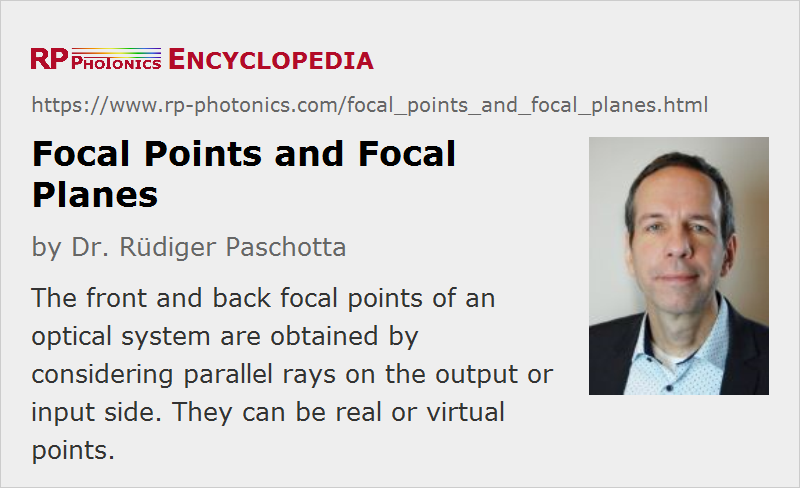Focal Points and Focal Planes
Definition: points to which parallel input rays are concentrated by an optical system, and the planes going through those points
German: Fokuspunkte und Fokalebenen
Author: Dr. Rüdiger Paschotta
Cite the article using its DOI: https://doi.org/10.61835/zk7
Get citation code: Endnote (RIS) BibTex plain textHTML
In Gaussian optics, one defines various types of cardinal points, to which the focal points belong. For the definition of the cardinal points, one does not consider the real light path in the optical system, but only the rays outside it, which can be extrapolated.
For defining the front focal point, we consider a situation where the output rays (right side) are parallel to the optical axis. Here, one can extrapolate the rays on the input side (left side) and finds that they meet in one point, which is the (real) front focal point (see Figure 1).

For a defocusing system (Figure 2), the front focal point can be located on the back side; this is a virtual focal point. It may be confusing that it is called a front focal point even though it is actually located on the back side.

The back focal point (or rear focal point) is obtained by considering a situation where the input rays (on the left side) are parallel to the optical axis. By again extrapolating the outgoing rays, one finds the back focal point (Figure 3).

For a defocusing system, the back focal point can be a virtual point located on the front side.
The focal planes are defined as the planes perpendicular to the optical axis which contain the focal points.
The focal points and planes can be found for any optical system, except if it is an afocal optical system. The front and back focal length is defined by the distance of the respective focal point from the corresponding principal plane.
Note that an actual beam focus does not have to be in a focal point; its position is different when the input beams are not corresponding to parallel rays. As an extreme example, consider a microscope objective. It receives light from a small object which is closely located to the entrance of the objective, usually not far from the front focal plane. The corresponding rays will be nearly parallel at the output and thus not meet in the back focal point. Instead, the image point will be far away from the objective, or even lie at infinity. Clearly, the two focal planes are not conjugate planes.
More to Learn
Encyclopedia articles:
Questions and Comments from Users
Here you can submit questions and comments. As far as they get accepted by the author, they will appear above this paragraph together with the author’s answer. The author will decide on acceptance based on certain criteria. Essentially, the issue must be of sufficiently broad interest.
Please do not enter personal data here; we would otherwise delete it soon. (See also our privacy declaration.) If you wish to receive personal feedback or consultancy from the author, please contact him, e.g. via e-mail.
By submitting the information, you give your consent to the potential publication of your inputs on our website according to our rules. (If you later retract your consent, we will delete those inputs.) As your inputs are first reviewed by the author, they may be published with some delay.

 general optics
general optics



2021-03-12
How can you draw light rays without arrows? It is so confusing.
The author's answer:
As the light can propagate in any direction, I see no reason to restrict it.